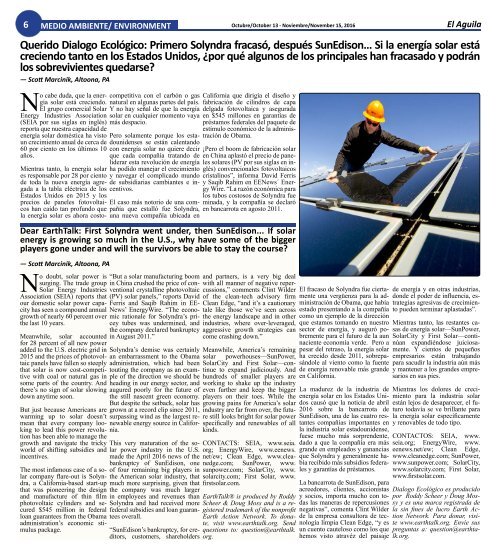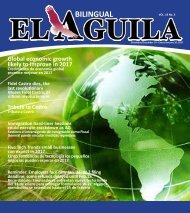El Aguila Magazine – October 13, 2016
Create successful ePaper yourself
Turn your PDF publications into a flip-book with our unique Google optimized e-Paper software.
6 MEDIO AMBIENTE/ ENVIRONMENT Octubre/<strong>October</strong> <strong>13</strong> - Noviembre/November 15, <strong>2016</strong> <strong>El</strong> <strong>Aguila</strong><br />
Querido Dialogo Ecológico: Primero Solyndra fracasó, después SunEdison… Si la energía solar está<br />
creciendo tanto en los Estados Unidos, ¿por qué algunos de los principales han fracasado y podrán<br />
los sobrevivientes quedarse?<br />
— Scott Marcinik, Altoona, PA<br />
No cabe duda, que la energía<br />
solar está creciendo.<br />
<strong>El</strong> grupo comercial Solar<br />
Energy Industries Association<br />
(SEIA por sus siglas en inglés)<br />
reporta que nuestra capacidad de<br />
energía solar doméstica ha visto<br />
un crecimiento anual de cerca de<br />
60 por ciento en los últimos 10<br />
años.<br />
Mientras tanto, la energía solar<br />
es responsable por 28 por ciento<br />
de toda la nueva energía agregada<br />
a la tabla eléctrica de los<br />
Estados Unidos en 2015 y los<br />
precios de paneles fotovoltaicos<br />
han caído tan profundo que<br />
la energía solar es ahora costo-<br />
competitiva con el carbón o gas<br />
natural en algunas partes del país.<br />
Y no hay señal de que la energía<br />
solar en cualquier momento vaya<br />
más despacio.<br />
Pero solamente porque los estadounidenses<br />
se están calentando<br />
con energía solar no quiere decir<br />
que cada compañía tratando de<br />
liderar esta revolución de energía<br />
ha podido manejar el crecimiento<br />
y navegar el complicado mundo<br />
de subsidiarias cambiantes e incentivos.<br />
<strong>El</strong> caso más notorio de una compañía<br />
que estalló fue Solyndra,<br />
una nueva compañía ubicada en<br />
Dear EarthTalk: First Solyndra went under, then SunEdison... If solar<br />
energy is growing so much in the U.S., why have some of the bigger<br />
players gone under and will the survivors be able to stay the course?<br />
— Scott Marcinik, Altoona, PA<br />
No doubt, solar power is<br />
surging. The trade group<br />
Solar Energy Industries<br />
Association (SEIA) reports that<br />
our domestic solar power capacity<br />
has seen a compound annual<br />
growth of nearly 60 percent over<br />
the last 10 years.<br />
Meanwhile, solar accounted<br />
for 28 percent of all new power<br />
added to the U.S. electric grid in<br />
2015 and the prices of photovoltaic<br />
panels have fallen so steeply<br />
that solar is now cost-competitive<br />
with coal or natural gas in<br />
some parts of the country. And<br />
there’s no sign of solar slowing<br />
down anytime soon.<br />
But just because Americans are<br />
warming up to solar doesn’t<br />
mean that every company looking<br />
to lead this power revolution<br />
has been able to manage the<br />
growth and navigate the tricky<br />
world of shifting subsidies and<br />
incentives.<br />
The most infamous case of a solar<br />
company flare-out is Solyndra,<br />
a California-based start-up<br />
that was pioneering the design<br />
and manufacture of thin film<br />
photovoltaic cylinders and secured<br />
$545 million in federal<br />
loan guarantees from the Obama<br />
administration’s economic stimulus<br />
package.<br />
“But a solar manufacturing boom<br />
in China crushed the price of conventional<br />
crystalline photovoltaic<br />
(PV) solar panels,” reports David<br />
Ferris and Saqib Rahim in EE-<br />
News’ EnergyWire. “The economic<br />
rationale for Solyndra’s pricey<br />
tubes was undermined, and<br />
the company declared bankruptcy<br />
in August 2011.”<br />
Solyndra’s demise was certainly<br />
an embarrassment to the Obama<br />
administration, which had been<br />
touting the company as an example<br />
of the direction we should be<br />
heading in our energy sector, and<br />
augured poorly for the future of<br />
the still nascent green economy.<br />
But despite the setback, solar has<br />
grown at a record clip since 2011,<br />
surpassing wind as the largest renewable<br />
energy source in California.<br />
This very maturation of the solar<br />
power industry in the U.S.<br />
made the April <strong>2016</strong> news of the<br />
bankruptcy of SunEdison, one<br />
of four remaining big players in<br />
the American solar industry, that<br />
much more surprising, given that<br />
the company was much larger<br />
in employees and revenues than<br />
Solyndra and had received more<br />
federal subsidies and loan guarantees<br />
overall.<br />
“SunEdison’s bankruptcy, for creditors,<br />
customers, shareholders<br />
California que dirigía el diseño y<br />
fabricación de cilindros de capa<br />
delgada fotovoltaica y asegurada<br />
en $545 millones en garantías de<br />
préstamos federales del paquete de<br />
estímulo económico de la administración<br />
de Obama.<br />
¡Pero el boom de fabricación solar<br />
en China aplastó el precio de paneles<br />
solares (PV por sus siglas en inglés)<br />
convencionales fotovoltaicos<br />
cristalinos”, informa David Ferris<br />
y Saqib Rahim en EENews´ Energy<br />
Wire. “La razón económica para<br />
los tubos costosos de Solyndra fue<br />
minada, y la compañía se declaró<br />
en bancarrota en agosto 2011.<br />
and partners, is a very big deal<br />
with all manner of negative repercussions,”<br />
comments Clint Wilder<br />
of the clean-tech advisory firm<br />
Clean Edge, “and it’s a cautionary<br />
tale like those we’ve seen across<br />
the energy landscape and in other<br />
industries, where over-leveraged,<br />
aggressive growth strategies can<br />
come crashing down.”<br />
Meanwhile, America’s remaining<br />
solar powerhouses—SunPower,<br />
SolarCity and First Solar—continue<br />
to expand judiciously. And<br />
hundreds of smaller players are<br />
working to shake up the industry<br />
even further and keep the bigger<br />
players on their toes. While the<br />
growing pains for America’s solar<br />
industry are far from over, the future<br />
still looks bright for solar power<br />
specifically and renewables of all<br />
kinds.<br />
CONTACTS: SEIA, www.seia.<br />
org; EnergyWire, www.eenews.<br />
net/ew; Clean Edge, www.cleanedge.com;<br />
SunPower, www.<br />
sunpower.com; SolarCity, www.<br />
solarcity.com; First Solar, www.<br />
firstsolar.com.<br />
EarthTalk® is produced by Roddy<br />
Scheer & Doug Moss and is a registered<br />
trademark of the nonprofit<br />
Earth Action Network. To donate,<br />
visit www.earthtalk.org. Send<br />
questions to: question@earthtalk.<br />
org.<br />
<strong>El</strong> fracaso de Solyndra fue ciertamente<br />
una vergüenza para la administración<br />
de Obama, que había<br />
estado presentando a la compañía<br />
como un ejemplo de la dirección<br />
que estamos tomando en nuestro<br />
sector de energía, y auguró pobremente<br />
para el futuro de la aun<br />
naciente economía verde. Pero a<br />
pesar del retraso, la energía solar<br />
ha crecido desde 2011, sobrepasándole<br />
al viento como la fuente<br />
de energía renovable más grande<br />
en California.<br />
La madurez de la industria de<br />
energía solar en los Estados Unidos<br />
causó que la noticia de abril<br />
<strong>2016</strong> sobre la bancarrota de<br />
SunEdison, una de las cuatro restantes<br />
compañías importantes en<br />
la industria solar estadounidense,<br />
fuese mucho más sorprendente,<br />
dado a que la compañía era más<br />
grande en empleados y ganancias<br />
que Solyndra y generalmente había<br />
recibido más subsidios federales<br />
y garantías de préstamos.<br />
La bancarrota de SunEdison, para<br />
acreedores, clientes, accionistas<br />
y socios, importa mucho con todas<br />
las maneras de repercusiones<br />
negativas”, comenta Clint Wilder<br />
de la empresa consultora de tecnología<br />
limpia Clean Edge, “y es<br />
un cuento cauteloso como los que<br />
hemos visto atravéz del paisaje<br />
de energía y en otras industrias,<br />
donde el poder de influencia, estrategias<br />
agresivas de crecimiento<br />
pueden terminar aplastadas”.<br />
Mientras tanto, las restantes casas<br />
de energía solar—SunPower,<br />
SolarCity y First Solar—continúan<br />
expandiéndose juiciosamente.<br />
Y cientos de pequeños<br />
empresarios están trabajando<br />
para sacudir la industria aún más<br />
y mantener a los grandes empresarios<br />
en sus pies.<br />
Mientras los dolores de crecimiento<br />
para la industria solar<br />
están lejos de desaparecer, el futuro<br />
todavía se ve brillante para<br />
la energía solar específicamente<br />
y renovables de todo tipo.<br />
CONTACTOS: SEIA, www.<br />
seia.org; EnergyWire, www.<br />
eenews.net/ew; Clean Edge,<br />
www.cleanedge.com; SunPower,<br />
www.sunpower.com; SolarCity,<br />
www.solarcity.com; First Solar,<br />
www.firstsolar.com.<br />
Dialogo Ecológico es producido<br />
por Roddy Scheer y Doug Mossy<br />
y es una marca registrada de<br />
la sin fines de lucro Earth Action<br />
Network. Para donar, visite<br />
www.earthtalk.org. Envíe sus<br />
preguntas a: question@earthtalk.org.
















